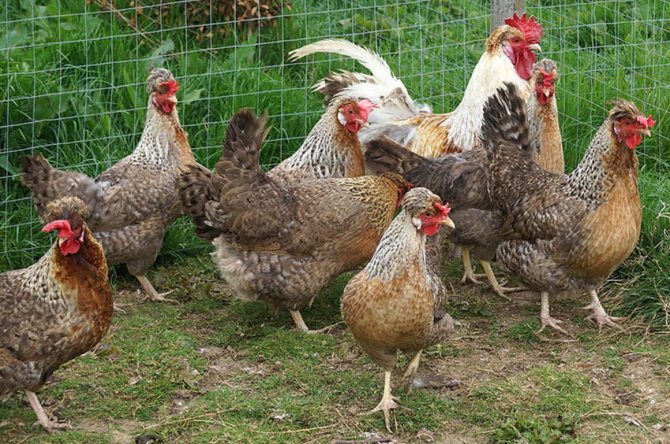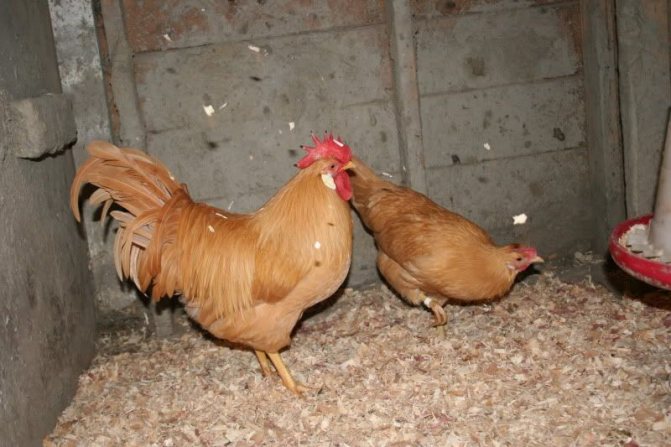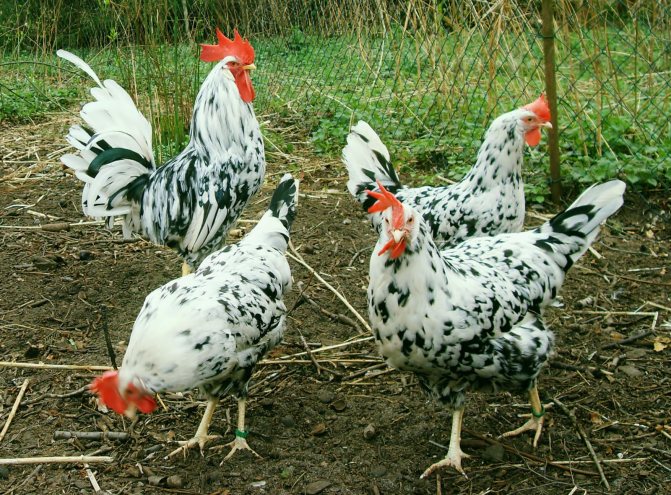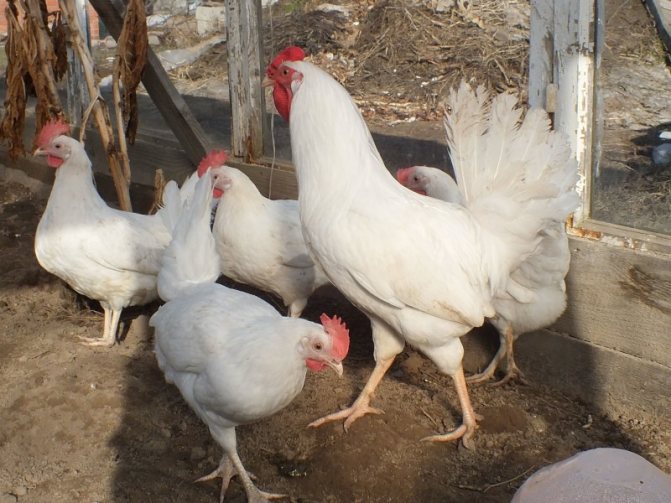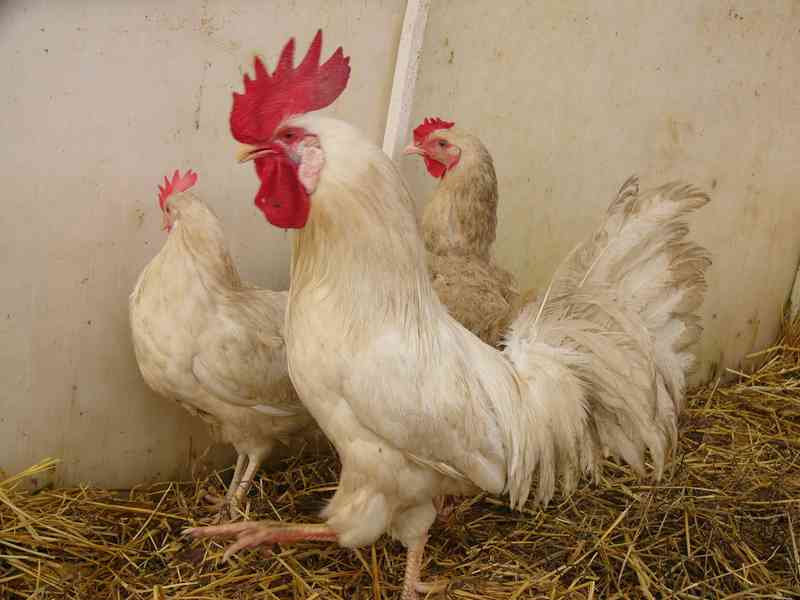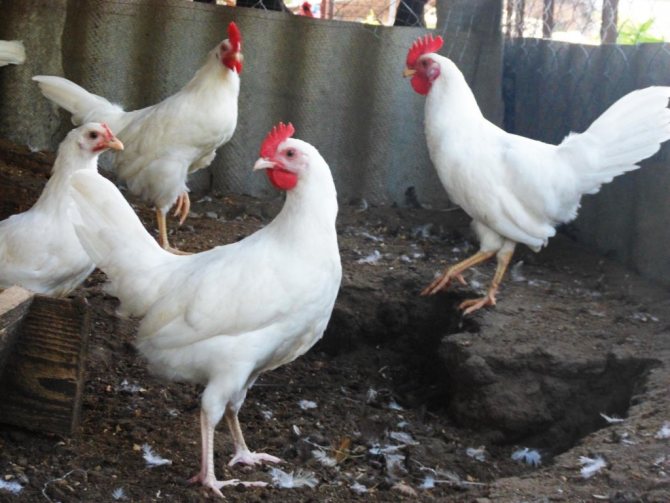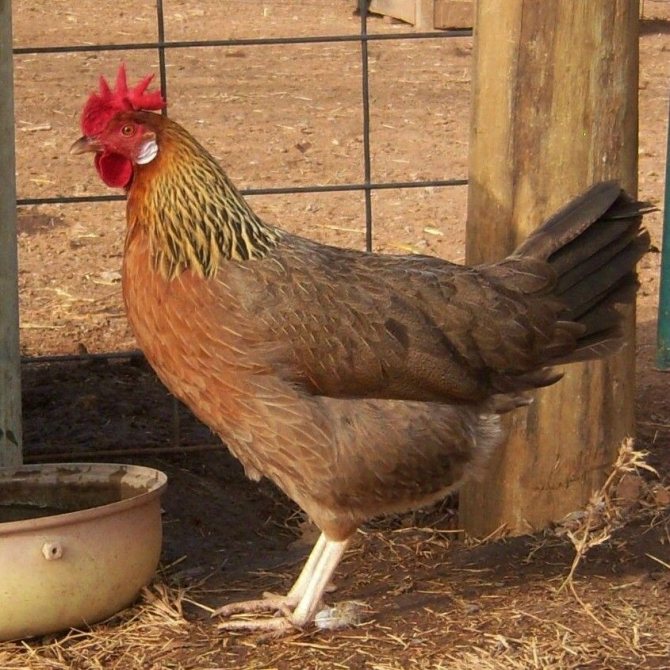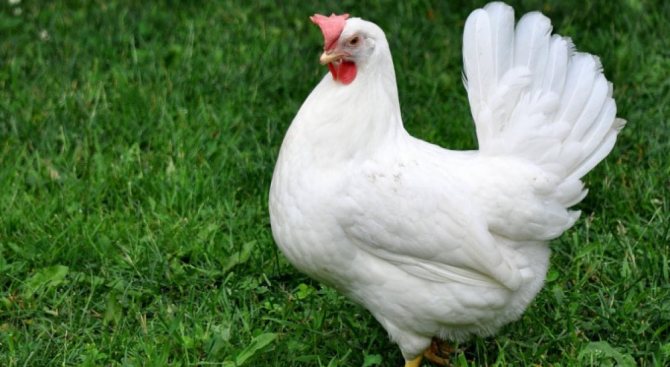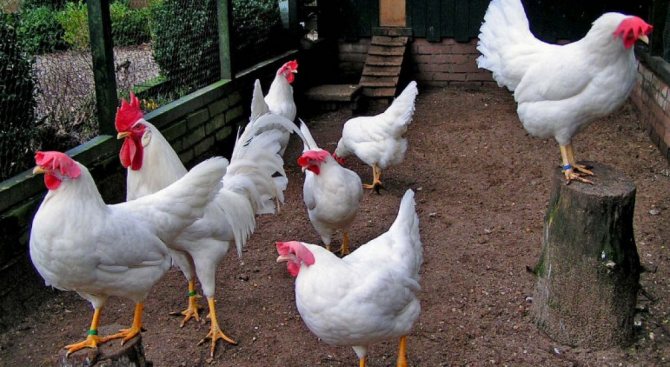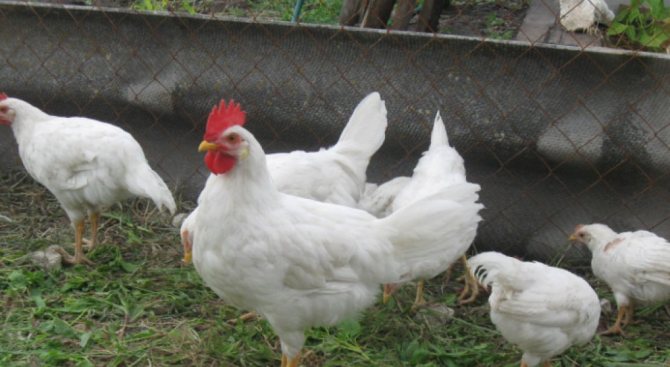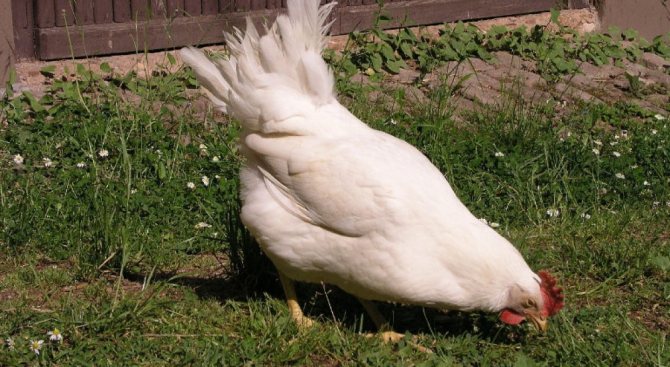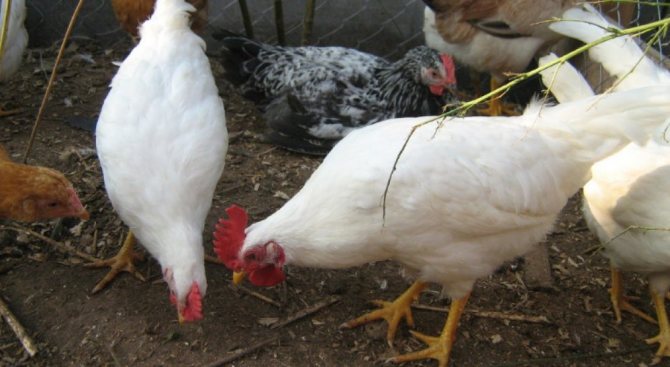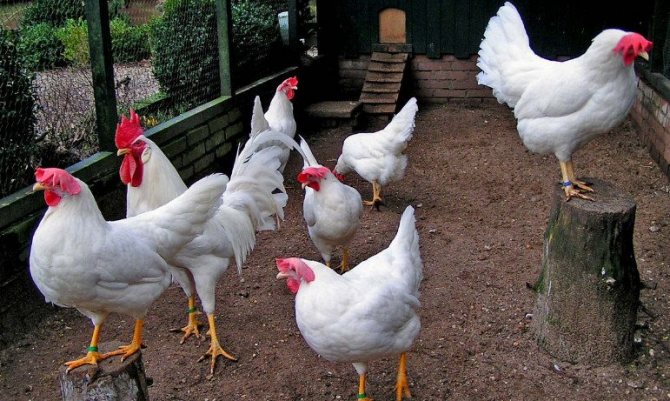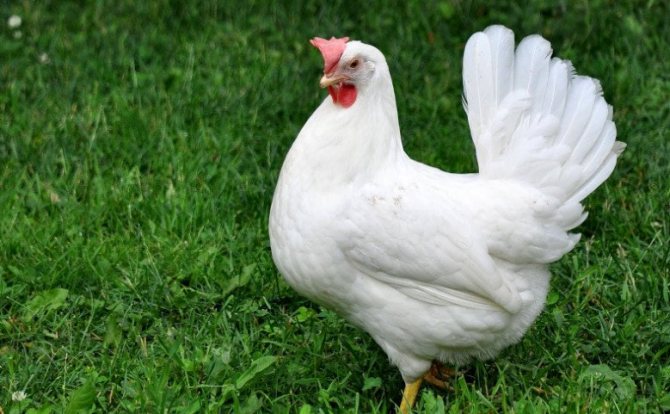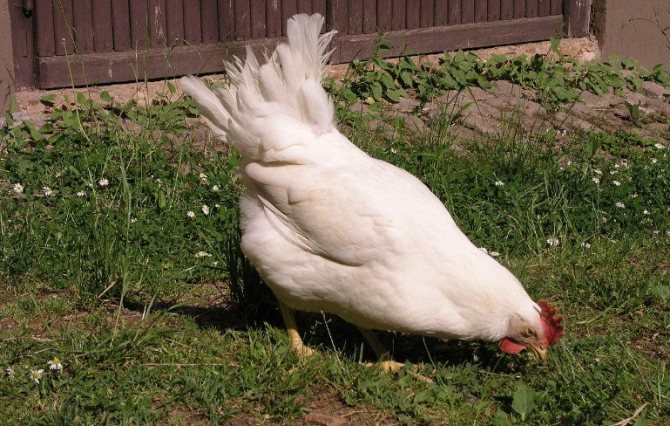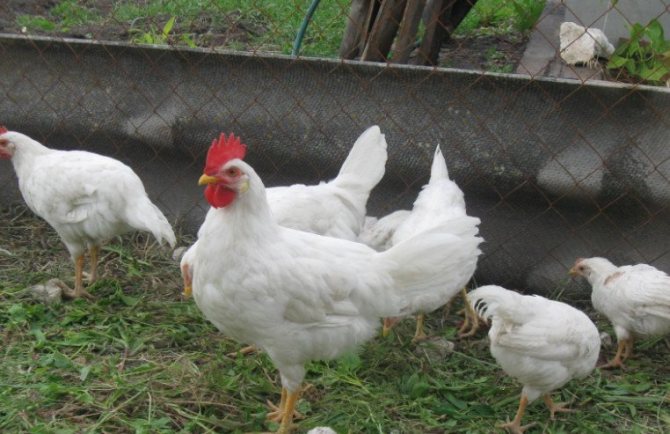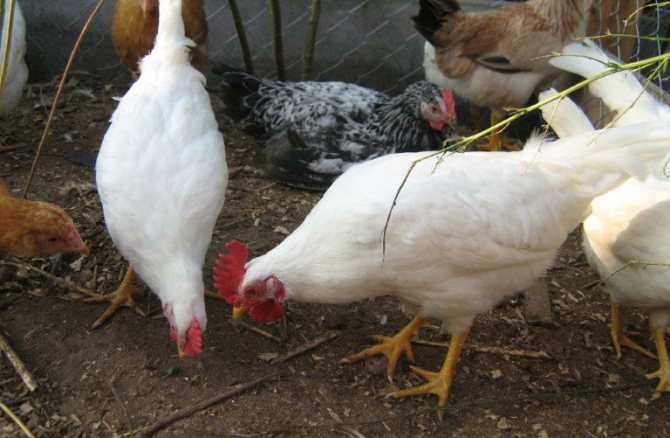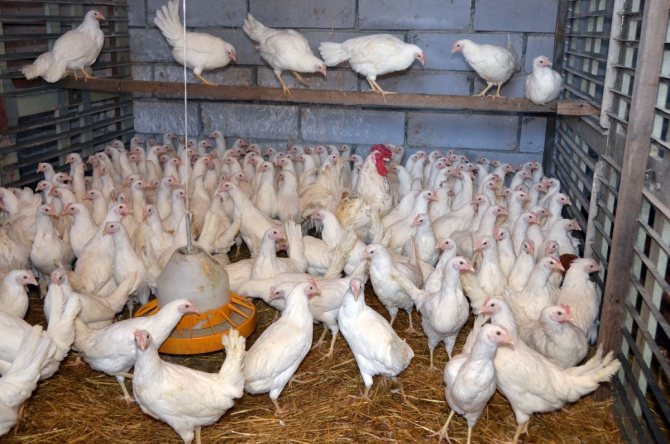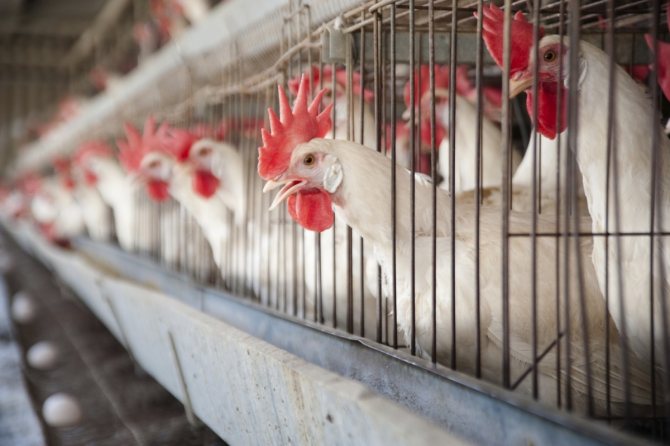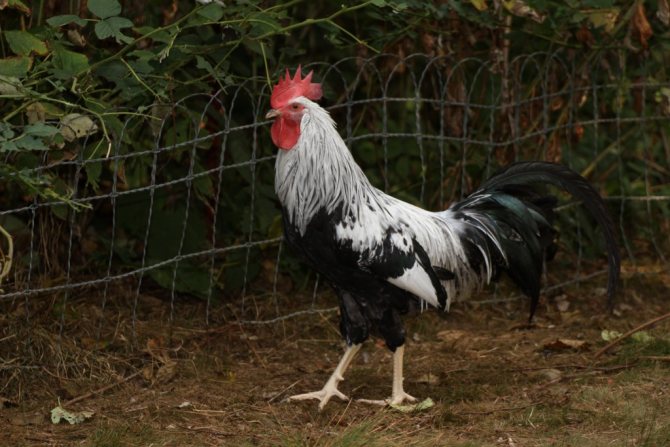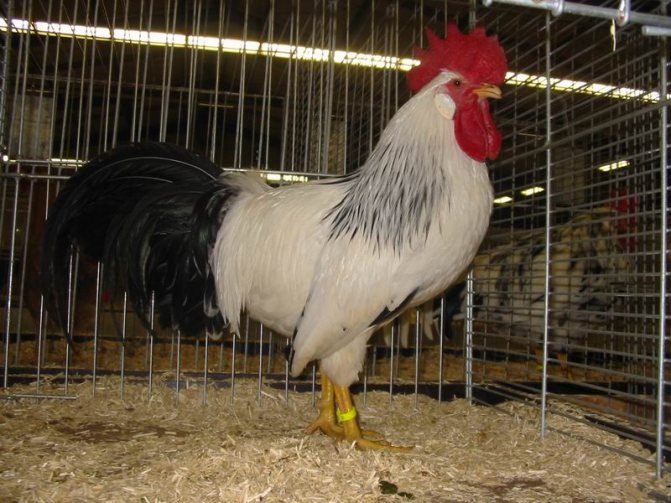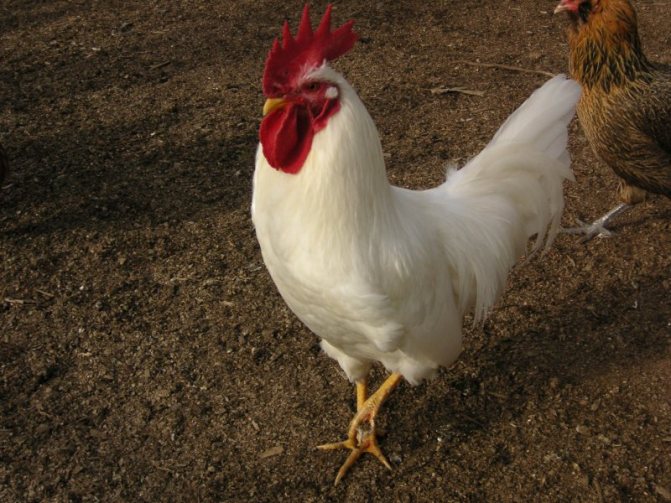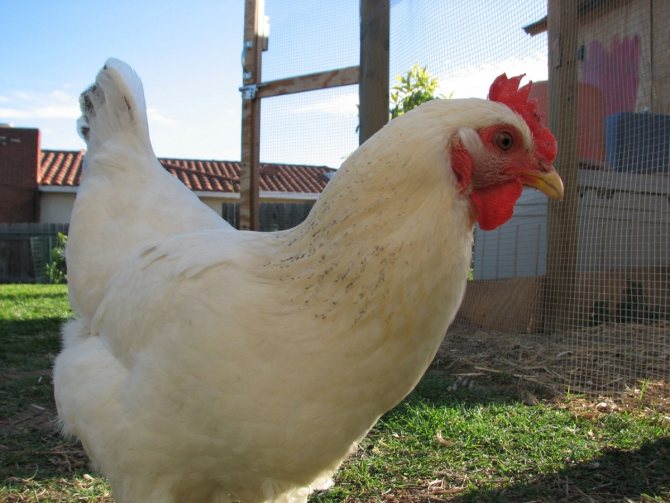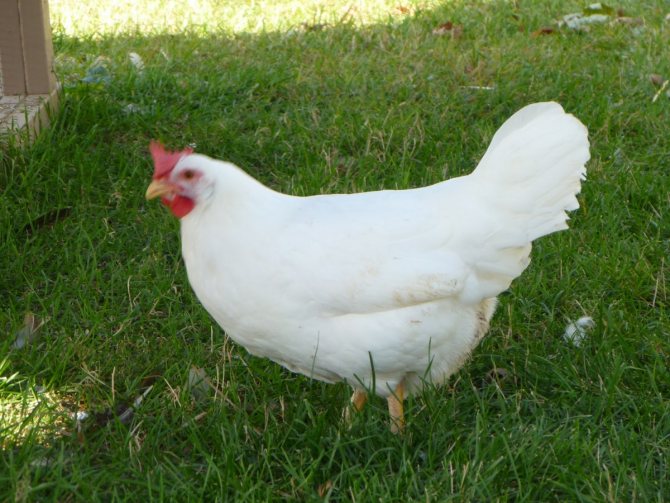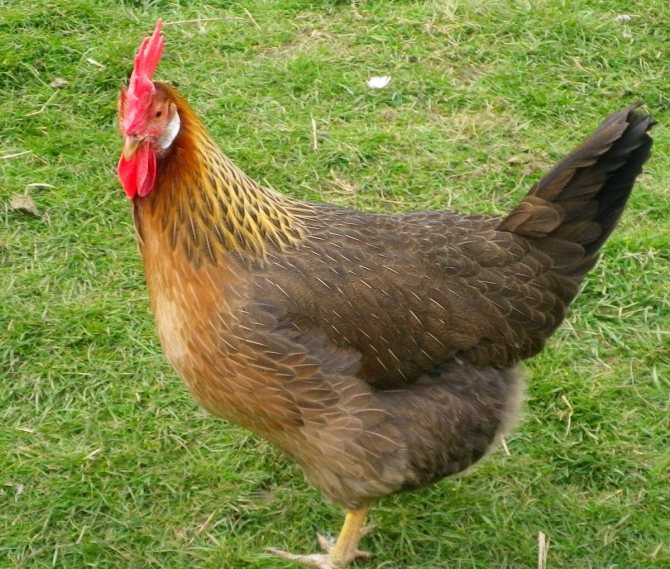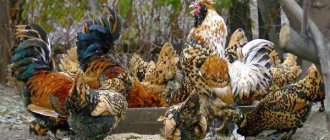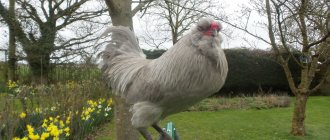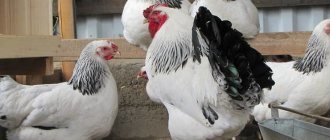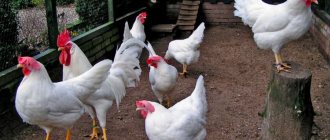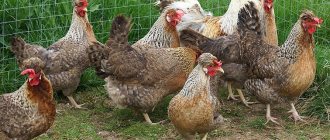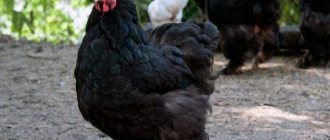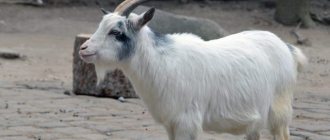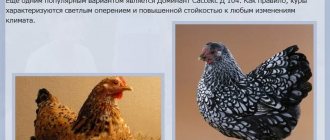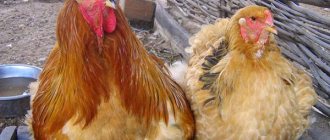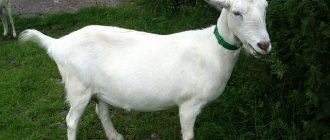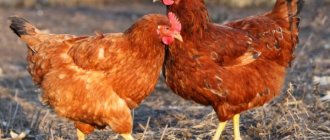Leghorn chickens today are the main material for obtaining crosses of the egg direction. The bird is found with more than 20 variations of feather color, but it is the white chickens, familiar to all poultry breeders, that have the maximum egg production.
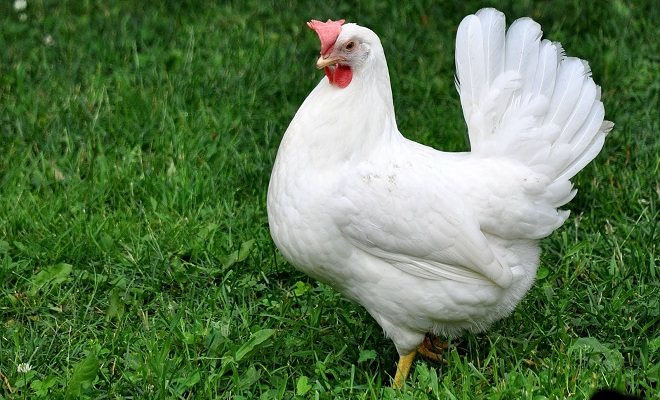
Leghorn - the most highly productive breed of egg-based domestic chickens
They are only slightly inferior to the crosses that are derived from them. Unlike hybrids, Leghorns can be bred at home from the parent flock. With proper care, white leghorn pleases the breeder with large, tasty eggs that it lays all year round.
Origin
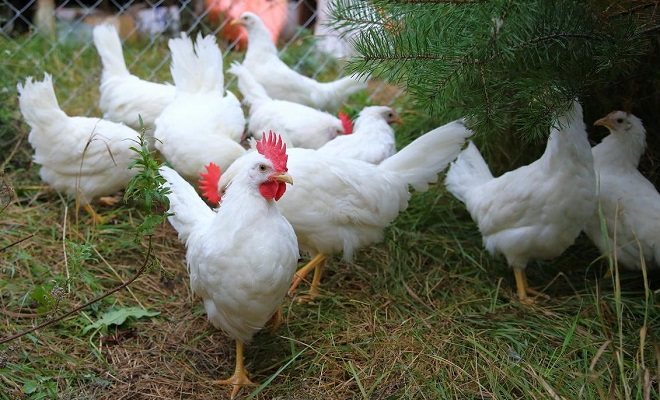

Chickens of Mediterranean origin
The Leghorn breed of chickens begins its history in Italy, where it was recorded in the 19th century. Birds named after the port of Livorno.
Before the breeding work, chickens did not differ in special productivity and did not stand out among other birds with average indicators. After the bird was introduced to the United States, work began to improve its productive qualities. For this, Leghorn chickens, whose characteristics were higher, were crossed with a fighting bird, several types of decorative Japanese chickens and a Minorca. Thanks to these efforts, breeders have obtained a particularly productive breed with a high indicator of vitality.
In Russia, Leghorn chickens appeared at the beginning of the 20th century.... Their content was not difficult, and they quickly gained special popularity. Chickens could easily acclimatize in various conditions and at the same time not reduce their egg production.
Breeding
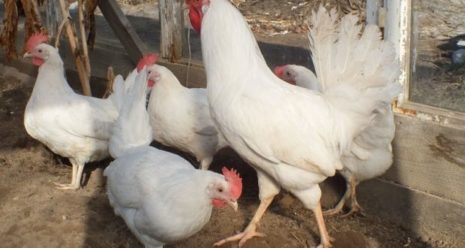

Birds do not have an instinct for incubation, which is even a plus for some farmers, because when incubating eggs, the chickens stop laying. Incubators are used to hatch the young. Males are very fertile, so the fertility of eggs is high, almost 96%. The hatchability rates of young animals range from 88 to 93%. Chicks are born 21 days after laying the eggs in the incubation box. They are distinguished by high vitality; after 14 days, the fluff of the chicks is replaced by plumage.
Young growth care
You may be interested in: How to feed laying hens in winter at homeHow to make an automatic feeder for chickensWhat to treat coccidiosis in broilers at home
The first time after birth, chickens need care and a lot of attention. Contamination of the litter should not be allowed, this can provoke the development of diseases. Chicks need to be provided with warm shelter; cardboard boxes or wooden boxes with high sides are most often used as dwellings. Infrared lamps are used for heating, the optimum temperature for day-old chicks is 28-30 degrees. Over time, it is reduced, by two months, bringing it to 18-20 degrees. You can understand whether chicks are hot or cold by observing their behavior. If the chickens are pressed against each other, they are frozen. If they run up in the corners, then they are hot. It is necessary to provide round-the-clock access to water for chicks, it must be clean and warm.
Advice!
Experienced poultry farmers recommend vaccinating chickens, this will save them from dangerous diseases.
There should be 6-8 meals a day. Everything that is not eaten in half an hour is thrown away. Boiled eggs can be stored in refrigerators for 24 hours, the rest of the food is prepared just before feeding.The diet of day-old chicks is mainly boiled eggs and semolina or corn grits, in addition, the food should be warm. From 2-3 days, greens, crushed cereals, dairy products are introduced into the diet, from day 5 you can feed the chickens with pre-start feed, from a week of age it is replaced with a starting feed. Also, the diet should contain boiled roots, vegetables, vitamin and mineral supplements. Fish and meat and bone meal are considered essential components of the nutrition of the younger generation. At two months old, chicks can be moved to an adult flock.
Content
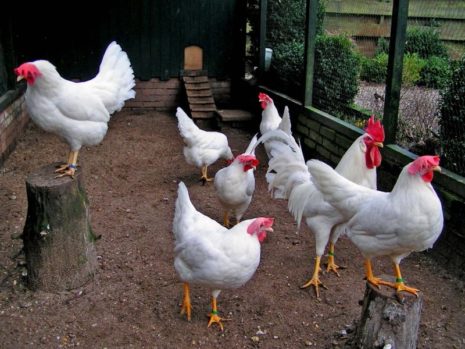

Chickens "Leghorn" are not large in size, so they do not need a large dwelling, but birds do not like crowding either. Perches are placed at eighty centimeters from the floor. The nests are placed at approximately the same height and can be attached to the wall of the chicken coop. There should be several feeders and drinkers, they are installed not only indoors, but also on the outdoor yard. There are no special requirements for the chicken coop, it must be warm and always with a window or ventilation. The room temperature should be at least +5 degrees Celsius, and the air humidity should not exceed 45-60%. A bedding layer is placed on the floor with a layer of at least 45 cm, it will retain heat and create a suitable microclimate in the chicken coop. Chickens can also be kept in cages, even in a small space, the birds are comfortable. Containers with food and water are hung on the door.
The walking area can be fenced off with a chain-link, it must be at least 150 centimeters high, since the birds fly well and can fly over the fence. Troughs filled with river sand mixed with wood ash will help protect chickens from parasites. In winter, even in frosts, the birds are taken out for a walk, this contributes to an improvement in egg production. Also, chickens need to provide 12-13 hour daylight hours.
As for caring for chickens, it consists in:
- regular cleaning of the premises where birds live;
- annual disinfection of the chicken coop;
- regular examination of the livestock for the presence of parasites and diseases;
- organization of the regime;
- feeding the herd;
The diet
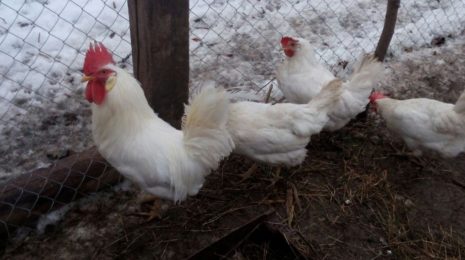

Leghorns are fed 3 times a day, the first and last feeding should consist of grain crops, it is recommended to add dry vitamin supplements to them, as well as table salt and chalk. For lunch, they usually give mash, in winter it is better to steam them with meat or fish broths and give them warm. In summer, vegetables, boiled root vegetables, finely chopped greens or carrot and beet tops are added to the mash. In the warm season, while walking, birds get some of their food on their own, eating worms, bugs and greens.
Interesting!
Chickens eat 110-130 grams of food per day.
In winter, the missing vitamins are replenished with special nutritional supplements. In order for egg production to be consistently high, meat and bone and fish meal, as well as dairy products, must be present in the diet. A container with small pebbles or shells is placed separately.
Leghorn appearance and breed standards
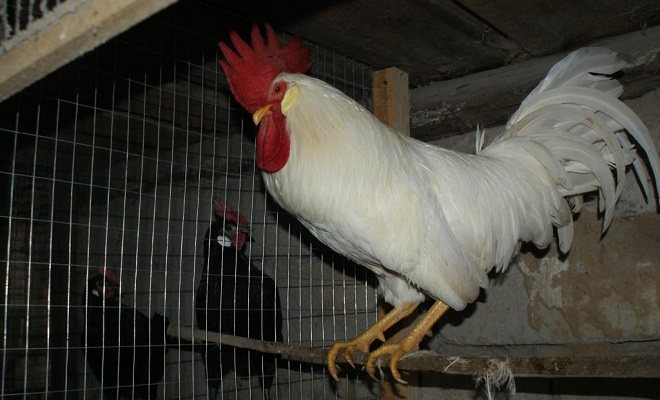

In Leghorn chickens, the color of the feathers is due to genetic characteristics. They can be found not only white, but also black, blue, golden and variegated (Dalmatians). Birds with white plumage are more popular, since their egg production is several times higher than that of colored ones.
The external standards for the White Leghorn breed are:
- body raised up;
- elongated body shape;
- average head size;
- a leaf-shaped crest hanging to one side in chickens and standing on cocks;
- large red earrings;
- the color of the lobes is from white to slightly bluish;
- yellow iris in birds older than 1 year old and orange in birds younger than 1 year old;
- well-developed round chest;
- straight back;
- strong paws of medium length;
- a wide, long tail in a rooster, located at an angle to the body of 40 degrees, and in chickens - at 60–90 degrees;
- dense dense plumage.
The standard size birds weigh between 1.4 and 2 kg for a chicken and between 2.2 and 2.7 g for a rooster. Mini Leghorns weigh less: chickens up to 1.4 g, and roosters up to 1.7 g. Otherwise, dwarf chickens are no different from birds of a standard size.
Subspecies and color
The most popular subspecies are considered to be chickens with classic white plumage. They are also the most ancient. They were bred in the 19th century thanks to the crossing of white Leghorns with several species at once (Minorcs, fighting pedigree and Japanese decorative).
Despite the name of the subspecies, chickens are not always white. The plumage can be yellowish, beige, light brown.
White leghorns have the highest fertility and immunity. However, there were times when chickens pecked the shells of their eggs and ate the embryos.
Leghorn Dalmatian
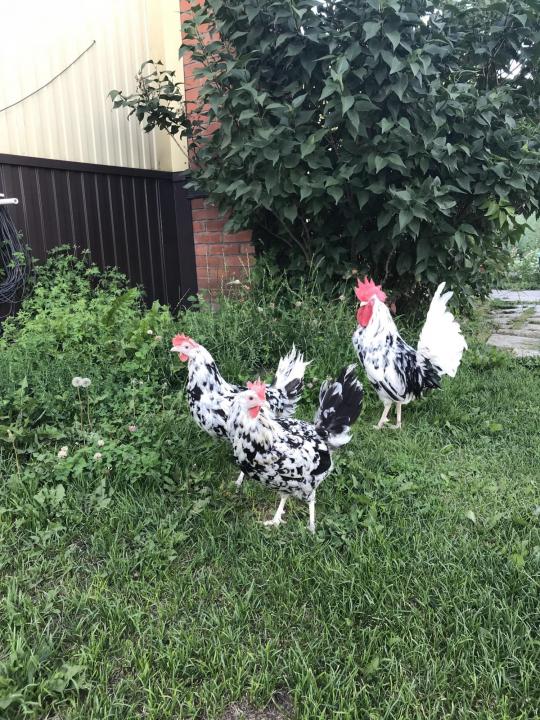

Due to the non-standard plumage, opinions arose that the subspecies was close to extinction. But this turned out not to be so - the breed data of the Dalmatians are at a high level.
Isabel
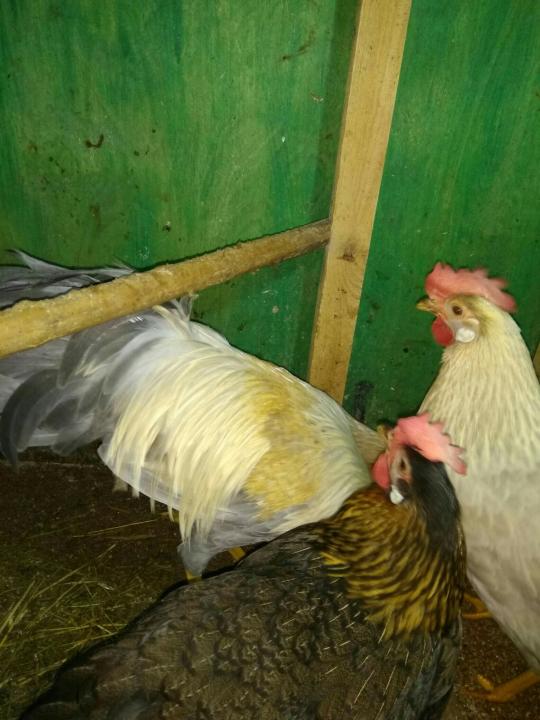

This view can hardly be called classic either. The main color of the rooster is ashy or silvery matte. And golden feathers appear on the back. The subspecies is considered decorative.
Silver
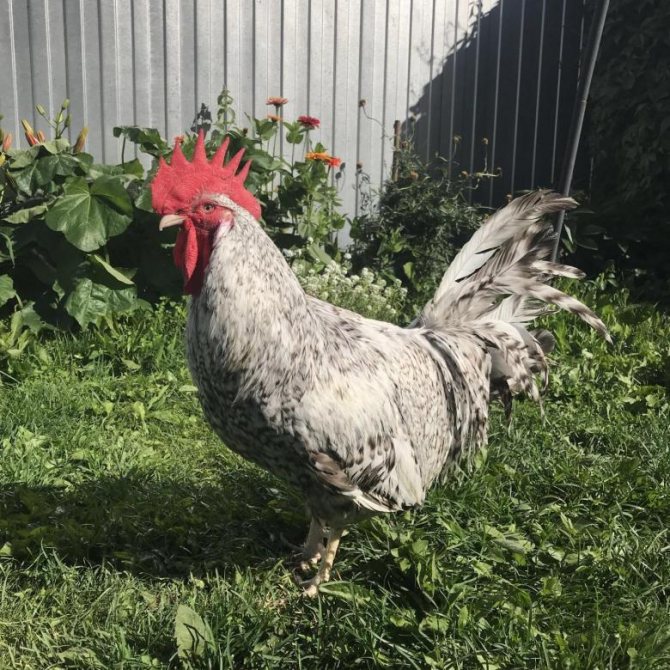

According to their characteristics, they are the best hens. They rush all year round. They willingly make contact with people, they do not create problems.
Lavender
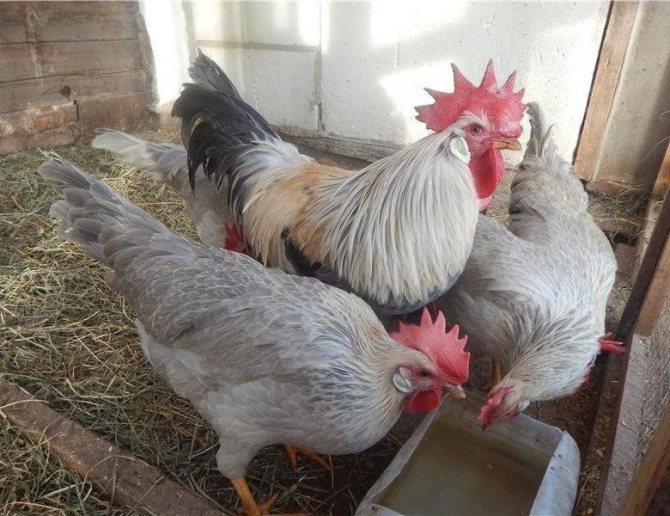

The most unpopular subspecies. Although the color of the birds is interesting, the productivity is lower than that of the rest. Chickens are susceptible to viral diseases.
Pygmy leghorn
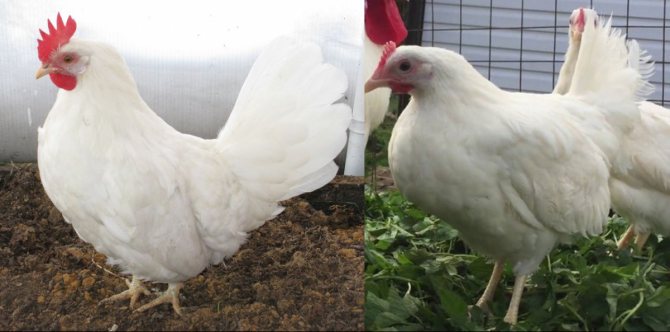

It looks like an ordinary white leghorn. Due to the dwarfism gene, the bird is miniature and low. The mass of the subspecies is on average up to 1.4 kg. Chickens are fertile, they are not prone to diseases.
Varieties of the breed
In private farmsteads, the maintenance of layers of white and dwarf leghorns is practiced, which consumes 35% less feed.
White
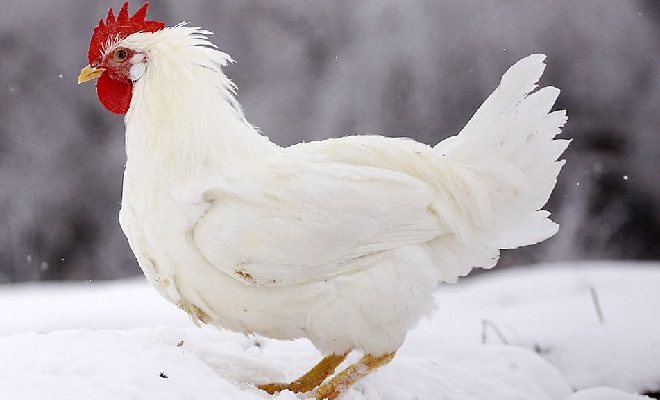

White Leghorn is suitable for both outdoor and cage keeping. At the enterprises, the poultry is stimulated with the help of special premixes, due to which it is possible to achieve especially high egg production. up to 300 eggs per year... Without stimulants, in a caged environment, a chicken can lay up to 200 days a year. With free-range chickens, they carry in almost the same way as in the presence of stimulants in the cage.
During life in cages on stimulant premixes, laying hens stay no more than 1 year, since bait destroys their body. When poultry is kept industrially, hormones and antibiotics are given to prevent overcrowding and dirt from dying. In addition, in poultry farms, females that begin to sit on eggs are destroyed, since their productivity is significantly reduced.
Dwarf (B-33)
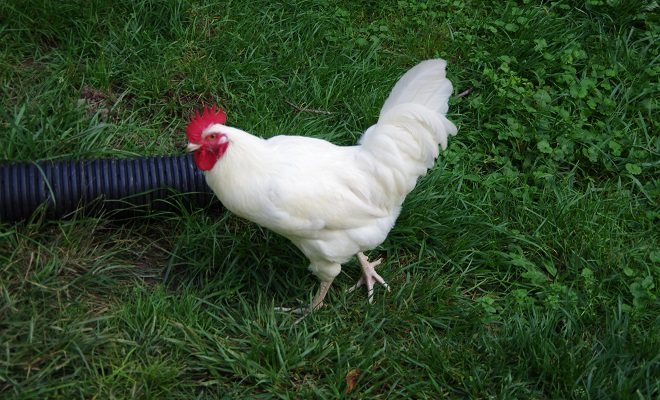

Dwarf Leghorn or B-33 is reduced in size due to the presence of a recessive dwarf gene. The survival rate of chickens and chicks is high, as is the case with standard poultry. The plumage of dwarfs is white. Birds adapt very well to different climatic conditions. Large space is not required for poultry walking.
A distinctive feature that dwarf leghorns have is a particularly high fertility of eggs. For them, it reaches 95%. This is due to the fact that the Leghorn rooster is very active and efficiently tramples all chickens.
Due to the fact that the gene for diminutiveness disrupts the metabolism in the body of a bird, the breeder must carefully consider her diet... If there is too much protein in it, then the youngsters have twisting of the fingers, after which atrophy and necrosis of the paw develops, due to which the chick dies. For this reason, for high-quality rearing of young stock, it is best to use special balanced feed.
Description of Leghorn chickens
Due to the fact that the breed is quite old and very popular all over the world, today many countries have their own standards for local Leghorn populations. In fact, in each country, the breed is represented by several intra-breed types, used mainly by local poultry farms. In such conditions, the global standard is a fairly conventional concept.
With all the variety of Leghorns, they all have a fairly small constitution, which is generally characteristic of egg-chickens. Their torso is wedge-shaped with a rounded and slightly protruding chest. The back is wide and elongated, concave in the center. The head is small, decorated with a bright red ridge of rather large size. In Leghorn roosters, it is usually erect, while in chickens it is hanging to one side. The neck is long, even slightly disproportionately long. But the legs are quite normal in length, but rather thin.
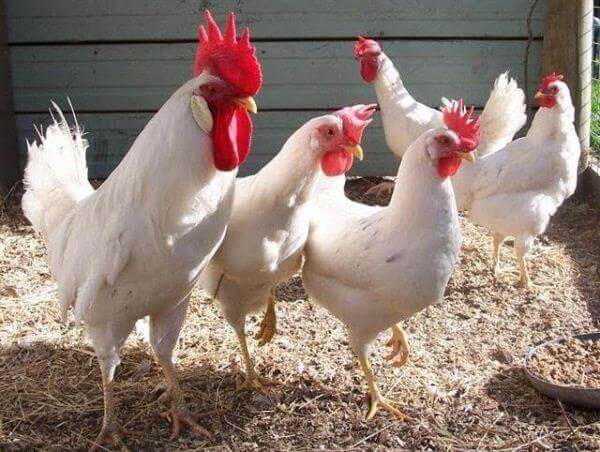

Both roosters and Leghorn hens have rather massive tail plumage. Sometimes you can distinguish between a chicken and a rooster only by the comb on the head.
While Leghorns are commonly thought to be snow-white chickens, there are actually several types of coloration, including partridge, fawn, and the unique spotted. However, some types of coloration are considered as a separate breed based on Leghorns. Industrial poultry has long been dominated by white leghorns, but as consumer demand for brown-shell eggs has grown, poultry farms have begun to pay more attention to the production of colored leghorns.
The nature of these birds is quite calm and even phlegmatic. Interestingly, since the breed is adapted for industrial breeding, the instinct of a brood hen is practically absent in chickens.
In addition to purebred chickens, there are many crosses bred on their basis. Most of them have a significantly different appearance from the parent breed, such as the miniature Leghorn dwarf.
Character
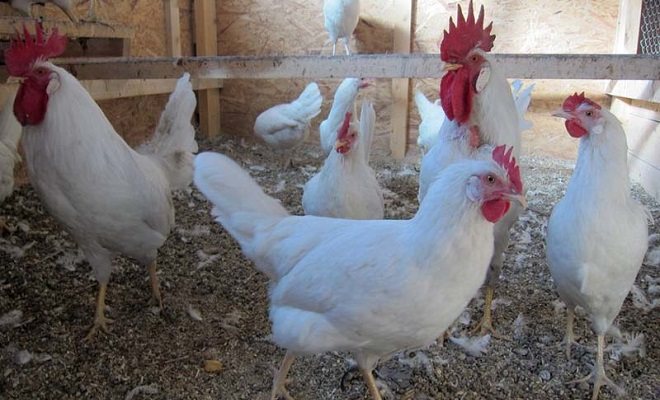

Leghorn chickens, the description of the productivity of which attracts poultry breeders, have a very lively character... They are actively moving, and therefore, ideally, it is necessary for them to arrange a walk with an earthen floor, so that they can, digging in the ground in search of pasture, spend maximum energy.
The bird's curiosity, combined with its low weight and strong wings, often causes shoots from open-air cages that do not have a roof. At the same time, it is quite difficult to return the pets back, since they are very shy and are not given into the hands of even the owner who raised them from chicken age.
Roosters love to sing and have a very loud and clear voice.... Despite this, the harsh sounds are shocking to Leghorns and should therefore be placed in a quiet location. If you scare the pets very much, then they can even kill themselves, rushing to the walls, looking for a way out.
White leghorns can be kept in the general house, but due to the aggressiveness of the males, the presence of more than 1 male in the house is unacceptable.
It is not uncommon for roosters to protect their territory from the owner, attacking him and trying to inflict damage with their beak and claws.
In order for the rooster to stop attacks, it is enough to give him a good rebuff with the help of an ordinary broom.
Diseases
The breed has strong immunity, but if an infection gets into the house, the sick chickens should be immediately isolated. With increased noise levels, chickens may develop noise hysteria. Chickens are especially susceptible to this disease at the time of laying. The disease is manifested by the aggressiveness of birds, they attack each other, scream loudly, beat against the walls. Chickens injure themselves and other individuals, while partially losing feathers. Naturally, this negatively affects egg-laying. Treatment consists of eliminating noise and creating a comfortable environment for the birds.
Productivity
The productivity of a bird is assessed by its egg production, since chicken is not of interest as a source of meat. Oviposition begins at 5 months of age. Thus, when buying pullets, the owner can be sure that they will start very quickly, as soon as they recover from the stress of the move. The first eggs are not large. After the first month of laying the bird, the egg becomes the maximum size with a mass of up to 65 g. Representatives of the Leghorn breed with white plumage give up to 300 eggs, and with colored ones - up to 250 eggs. Egg shells range in color from white to dark brown with a transition through different shades. In miniature chickens, egg indicators are the same.
Meat of the Leghorn breed has low taste, is very tough and can only be used for making broth.
In the subsidiary farm, only extra roosters and old chickens are allowed to eat meat, the egg production of which has dropped significantly. It makes no sense to breed poultry directly for meat.
Productivity indicators
In the industrial poultry industry, leghorns are raised exclusively for the production of eggs. In terms of egg production, the representatives of the breed are real record holders. One chicken can lay about 300 eggs per year.... With such an intense load, laying hens are quickly depleted, in the second year their productivity decreases, therefore it is necessary to regularly renew the livestock that has reached the age of 1.5 years. It is not necessary to count on a large yield of meat products - the mass of an adult is less than 2 kg (for females) and up to 2.5-2.7 kg (for males). In addition, the taste characteristics of the meat are low, it is tougher and drier than, for example, in the "Kuchinsky Jubilee".
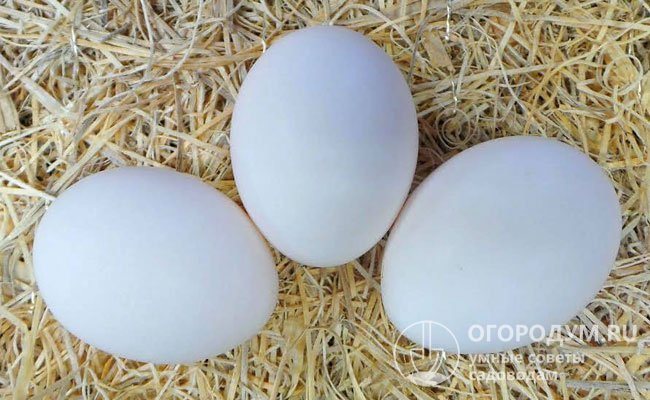

Eggs weighing an average of 55-58 g, with a white strong shell
The breed belongs to early maturing - maturity occurs at 4.5-5 months, from that time the chickens begin to rush. The eggs are large enough, the average weight of each is about 55 grams (maximum 70 g). The shell is white, with proper nutrition of the chickens, it is strong and hard.
Features of the content
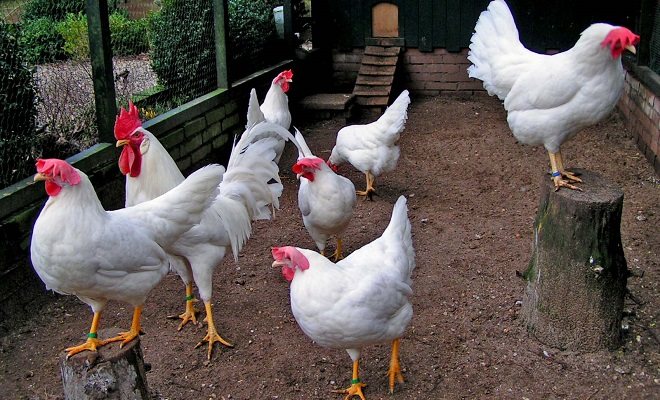

Leghorn - unpretentious chickens, and minimum conditions are required for their good condition.
Wanting to get the maximum number of eggs, chickens should be placed in a high-quality poultry house with good ventilation, no drafts, light and reliably insulated. A walk when kept in a private courtyard must be arranged in such a way that its fence is either high enough, since the chickens fly well, or it has a roof. It is important to provide chickens with quality perches at a height of 1 meter from the floor. Usually they easily jump on them, but for safety net it is worth arranging a ladder, along which, in case of poor health, the bird can climb up.
In winter, in order to maintain high productivity, it is necessary to provide the bird with lighting, since the minimum length of daylight hours should be 12 hours. An infrared lamp should be used for lighting, which will also provide additional heat.
Care
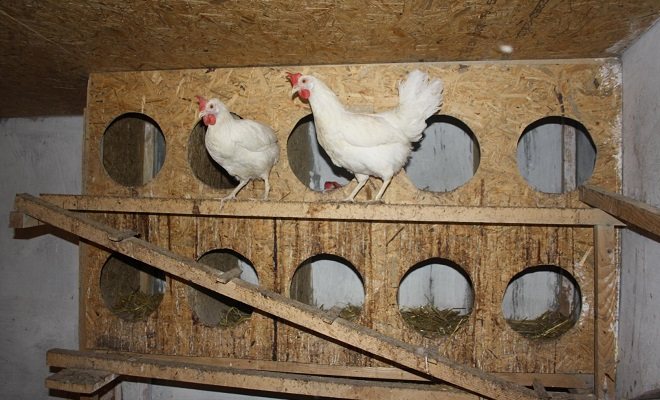

Laying nests
Caring for chickens is simple. To preserve the health of birds and their high productivity, it is necessary to clean the chicken coop at least 3 times a year, disinfect it and process it with lime once a year.
You also need to provide a sufficient number of nests. Since hens lay eggs at about the same time, for 2-3 chickens you need to arrange 1 nest... Drawers or spacious basins can be used for nests. It is necessary to collect the eggs as early as possible so that the bird does not trample them and does not taste the contents, since in this case, having tasted the contents, they may begin to beat them deliberately in order to obtain a treat.
Feeding
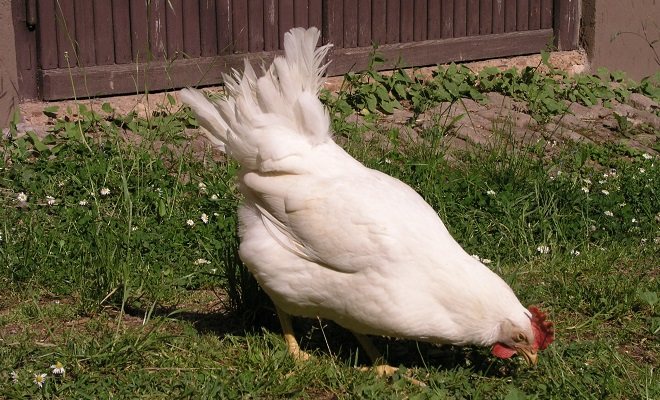

The bird rushes only with proper nutrition... It is best to feed the Leghorns with special layer mixes, adding vegetables and root vegetables. In the summer, hens should be given greens. In winter, it is replaced by hay or dry nettle flour.If the livestock is small, then green onions can be grown for the bird.
The water should always be clean and cool. You need to change it in the summer in the morning and in the evening, and in the winter - only in the morning.
Breeding
The Leghorns have lost their incubation instinct. They very rarely begin to cackle, and therefore, if you want to hatch chicks under a hen, you need to pick up a chicken of another breed. Most often, eggs are laid in an incubator to obtain chickens. If the incubation standards are observed, hatching turns out to be friendly.
Maintenance and care
Leghorns, unlike most other highly productive breeds, are not very picky and can adapt to almost any conditions. If the only goal of the breeder is to obtain eggs, then the cage option is best. With this technology, it is much easier to control the feeding regime of the birds, monitor their health and collect eggs. Laying hens may not be allowed out for walks at all. However, in this case, their meat will not be of any value in terms of commercialization.
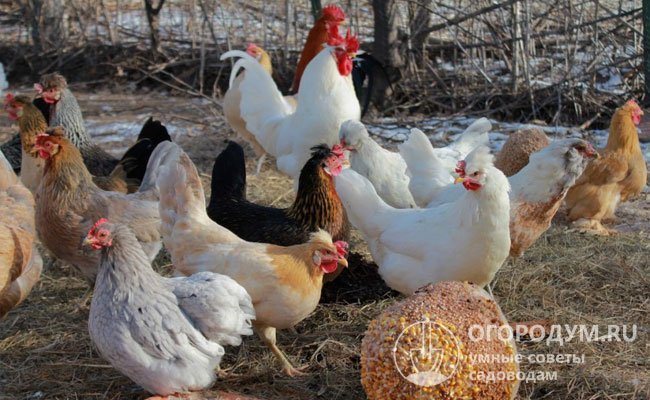

In households, in order to improve the quality of poultry meat, it is recommended to keep them not in cages, but to provide them with free range with the opportunity to eat pasture
For small private farms, it is more advisable to keep birds on the floor in a chicken coop and provide them with a walking area with a fence about 1.5 m high - although egg production rates may decrease slightly, the quality of meat will improve. In caring for an adult livestock, it is enough to comply with standard sanitary standards.
Leghorns, especially white ones, tend to peck eggs if they are too close in cages and aviaries, feather contamination, insufficient protein in food, harsh light. In large poultry farms, to prevent cannibalism, they resort to de-picking - cutting off the tip of the beak.
Feeding
There are no problems with feeding the Leghorns either. Due to their small size, chickens consume very little food. Almost everything they eat goes into egg production. The main thing is that the feed is of high quality, and the diet is balanced in terms of the ratio of proteins and minerals.
The basis of nutrition is made up of grain products (they must be constantly present in the feeders), wet mash and fortified feed. Birds need to mix bone meal and chalk in their food, and it is also important to provide them with free access to clean drinking water.
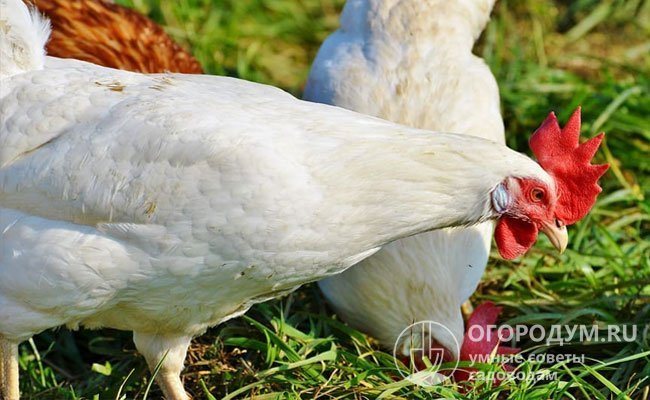

When organizing free range, birds can independently fill the need for missing micronutrients
For variety, Leghorns are given grass (hay in winter), various vegetables and fruits. Adults are usually fed 3 times a day according to an approximate scheme:
| Times of Day | Types of feed and the specifics of their giving |
| Morning | Corn |
| Noon | A mash based on water, broth (fish / meat) or sour milk products from bran, potatoes, carrots, melons, cabbage, apples, herbs (preferably nettle, quinoa, carrot and beet tops). After half an hour, food leftovers are removed so that they do not deteriorate. |
| Evening | Fortified mixed feed mixed with grain mixture |
You can learn more about the rules for feeding chickens of this breed from the following video:
Breeding
As a result of long-term selection aimed at increasing egg production, the chickens were completely rid of the maternal instinct, that is, the craving for incubating the clutch. For this reason, you will have to use an incubator for breeding or lay eggs under hens of other breeds. As a rule, chicks hatch on the 28th day.
During incubation, chickens appear from almost all eggs - the fertilization rate is at the level of 95%. The survival rate of chicks is also very high and is about 92-95%.
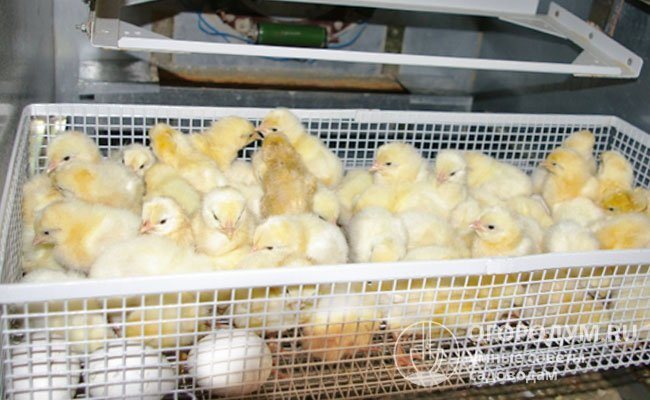

An incubator is required to produce Leghorn offspring, as chickens lack the instinct to incubate eggs.
Raising chickens
The hatched chicks are placed in a warm place with an air temperature of at least 30 ℃, then the temperature is gradually reduced. Youngsters by the age of one month feel great at 19 ℃. Constant lighting for babies is necessary only for the first 5 days, then the light is turned off at night so that they do not get over-excited and do not arrange fights in which they can injure each other.
In the first days of life, chickens are fed boiled eggs and semolina. As the chicks grow older, cottage cheese, vegetables, finely ground cereals, corn, green onions are gradually introduced into their diet. It is helpful to give shells, eggshells, sand, or rock chips.
For more information on how to care for young animals at home, see the following video:
Raising chickens
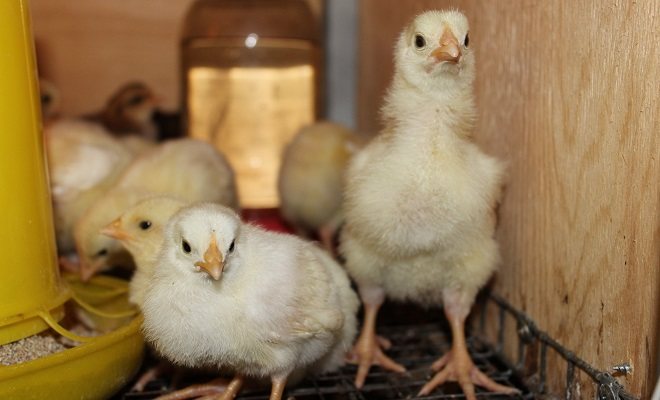

Leghorn chicks
After hatching, Leghorn chicks should dry out and then receive food immediately. The first day they are fed with finely chopped yolk and high-quality cottage cheese with low fat content. On day 2, steeply boiled millet is added. Crushed wheat groats should be constantly in young animals. Greens are added to chickens from 4 days. Chickens can be transferred to an adult diet from 3 weeks.
Keeping young animals is not difficult.
Breeding chickens
In Russia, Leghorns are bred mainly by large farms. For household owners, getting offspring is too difficult a task.
However, now incubators are available to everyone, and the breed fell in love with private owners for its unpretentiousness. White Leghorns are grown on farms, and Isabella is preferred in households.
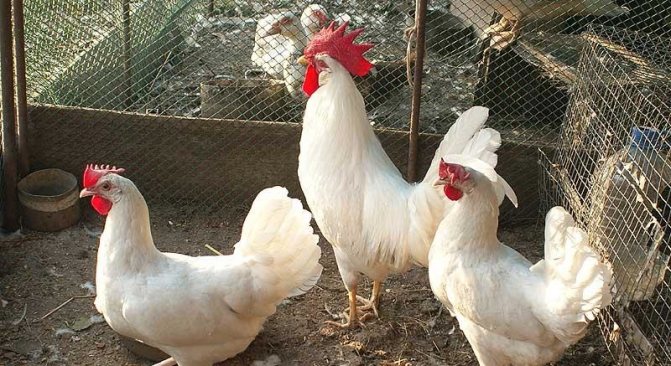

Incubation
Incubator eggs must be selected carefully. And for this you need to consider:
- Laying hen health and age. Only eggs of a young and completely healthy chicken no more than 1.5 years old are suitable for the incubator.
- Size and weight. For an incubator, eggs of at least 50 g are needed. With a stricter selection, at least 55 g. In one incubator there must be eggs of the same size.
- Exclude eggs from chickens that have been given fertility supplements. The more naturally the laying hen was fed, the more likely it was to get chickens.
- Standard egg shape and no shell irregularities.
Experienced farmers know that visual inspection is not enough and an ovoscope is indispensable. It will help you see microcracks in the shell, see the position of the yolk and see subtle spots.
It is not recommended to store eggs for more than 6 days before incubation. Before being placed in the incubator, they are placed in a room with a temperature of + 20ºC. It is more convenient to lay eggs at 18:00, then the chicks will hatch during the day.
It is necessary to calculate on what day the hatching of the chicks is planned in order to prepare brooders for them. The standard incubation time is 20 days, there may be errors of 1-2 days.
Chicks diet
The first few days, the chickens are fed with semolina (cereals) and boiled eggs. Later add green onions, cottage cheese, boiled vegetables.
When the chicks are 14 days old, you can start feeding them light gruel, which includes mainly greens and vegetables. After another couple of days, it's time to introduce minerals, chalk, fish oil, grated shells. While the chickens are small, they need to be fed at least 5 times a day in small portions. And after a month, transfer to three meals a day.
If everything is done correctly, the chicks survive, grow stronger and by 4 months they can already lay eggs.
Advantages and disadvantages
The strengths of chickens are:
- early maturity;
- high egg production;
- unpretentiousness;
- ability to live in a common poultry house.
Reviews of breeders indicate such shortcomings of the breed:
- short period of maximum egg production;
- the unsuitability of the bird for receiving the mass;
- absent incubation instinct.
Usually the merits of Leghorns outweigh their demerits.
Leghorn in industry and hobby farms
Excellent egg production makes Leghorn chickens one of the best options for commercial breeding. In our country, there are more than 20 enterprises where breeders are conducting research aimed at developing new varieties of such a productive variety.
With the advent of more and more egg-laying individuals, the maximum number of eggs laid is steadily growing: 200 units of the product per year no longer surprises the owners of Leghorn chickens. So you can not talk about the profitability of their breeding.
On industrial farms, hens are bred by the cage method. The cells are lined up, stand on top of each other, which is why they are not particularly clean.
To prevent the development of diseases that can be caused by pollution and crowding, owners of large poultry farms often give their pets antibiotics and hormones.
Naturally, this negatively affects the health of chickens, whose body is gradually depleted. However, for their owners, the main thing is to preserve the birds during the period of maximum egg production, at the end of which the layers are sent to slaughter.
Novice poultry farmers and hobby farmers also often prefer the Leghorns. In addition to productivity, many are attracted by the fact that birds are unpretentious in care and nutrition, and are also very friendly and can live with individuals of other breeds. If only white Leghorn is used in the industry, then on personal farms one can find individuals with an unusual color of plumage.
Most often they are brown hens, which differ from their relatives in that they lay eggs of large size and mass. True, in terms of egg production, they lose to white chickens, so they are preferred more often because of the product they produce. The eggshell is colored brown; the products themselves are in great demand on the market.
Photo gallery
Characteristic
Today, you can buy Leghorn chickens not only with white color. They are used as the main genetic material. Today, you can get on other breeds that are characterized by the same high productivity.
Faverol chicken breed description and other data are indicated in the article.
Brown
The considered breed of domestic chickens also has an egg direction. The main feature for them is the difference in the color of the plumage between females and males. Roosters have very bright colors. Their necks and back are covered with shiny plumage of a golden-red hue.
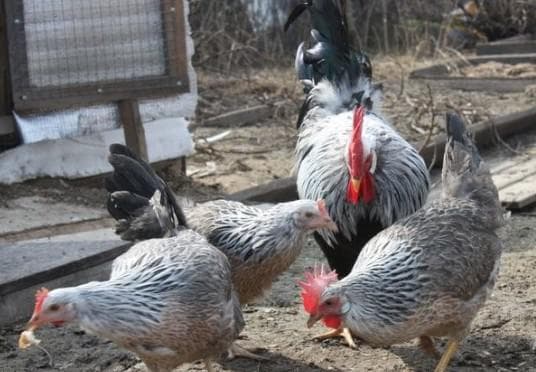

The sternum and belly are covered with black feathers, which are characterized by a rich green metallic sheen. For females, a more rapid color is characteristic, not so saturated.
You can see a photo of the Adler Silver breed of chickens in this article.
Cuckoo partridge birds
This type of poultry belongs to autosex chickens. It is possible to distinguish between chickens by sex after a day has passed since their eggs hatch. It is possible to identify males by the presence of a light cannon color.
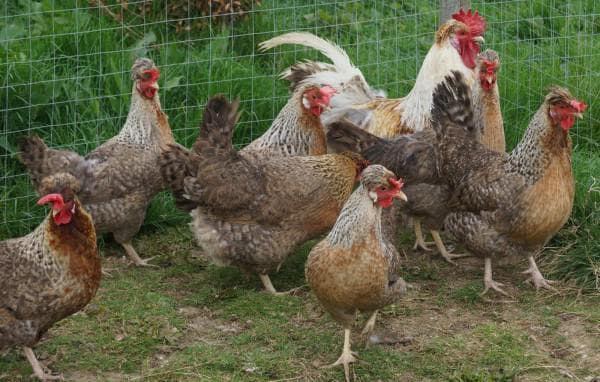

Keeping these animals is very simple, because they are not whimsical, like white leghorns. Chickens are very active, move a lot, and are always friendly when in a team.
Already adult females and males have clear distinctive features. The rooster has not only large sizes, but also a characteristic color. Chickens of the breed in question are characterized by high productivity, they lay eggs with white shells. But the size of the eggs is average. The maternity instinct in females is poorly developed. Adult birds weigh about 3.5 kg.
The article contains a photo of the Araucan chicken breed.
Golden
For birds with a golden color, small sizes are characteristic. Due to this, they are classified as decorative animals. But these chickens are characterized by high egg production. The laying hen is able to give its owners about 260 eggs per year. One egg weighs 60 kg, the shell is white. Males can weigh 2.2 kg and females 1.9 kg.
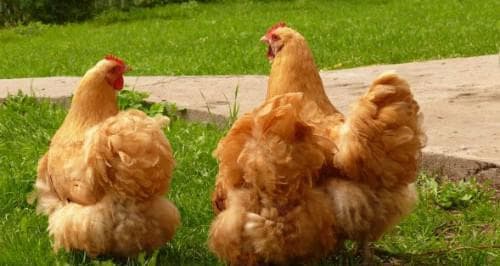

Spotted
When purchasing such a breed, you can be absolutely sure of its purebredity. The reason is that they are born almost abnormally, and in the future it was no longer mixed with any other species of birds.
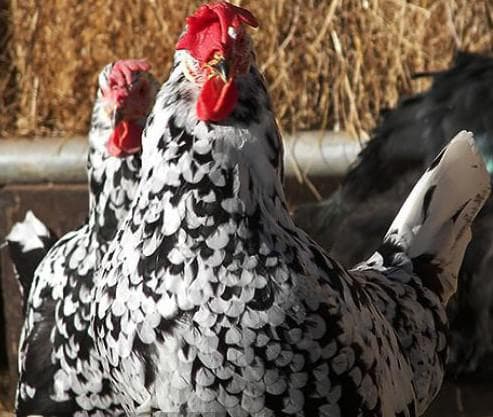

This unusual coloration is characteristic only of Leghorns. Their plumage has a very beautiful combination of black and white. At first glance, these two colors are located on the body of chickens in a chaotic manner. However, upon close inspection, you can make sure that the color has a clear pattern. These chickens have a high productivity, they are able to hatch 250 eggs per year (just like Redbro chickens). Everything in chickens ranges from 1.8 to 2.7 kg, it all depends on gender.
How to feed chickens correctly, you can find out by reading this article.
Poultry house arrangement
Leghorn - chickens, the description of which was given a little above, are completely undemanding to the conditions of detention. Caring for them is no different from caring for layers of any other breed. The shed can be built from concrete, brick, old sleepers, etc. However, most often poultry houses are made of frame-panel. In such structures, it is quite warm in winter, even without additional heating, and cool in summer.
It is better to make the floor in the barn wooden. But you can also pour concrete. A layer of straw or sawdust bedding must be placed on top. In the event that it is thick enough (at least 40 cm), the chickens will begin to lay well, including in winter. The fact is that such a litter in the cold season can work as a natural heater. In straw or sawdust, processes of overheating begin to occur, accompanied by the release of heat.
In the poultry house, a window is mandatory. It is also worth making the simplest ventilation by making holes in opposite walls (in one - at the top, in the other - at the bottom). In winter, you can just cover them with something.
A large aviary is set up next to the poultry house. It is best to fence off the walking area with a netting. The gate to the aviary is made from the yard. In the wall of the barn, a closable manhole is arranged, through which the Leghorn chickens themselves will go out for a walk. A photo of a suitable poultry house with an aviary can be seen below.
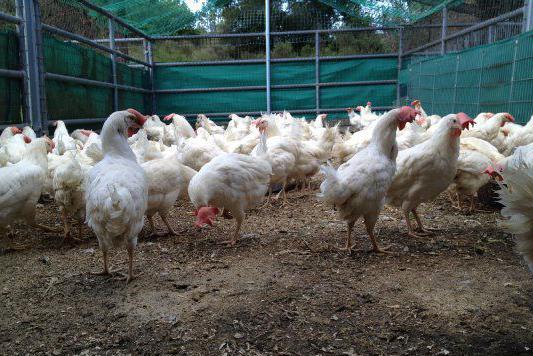

History
Chickens of the Leghorn breed were first bred by Italian breeders in the nineteenth century. This is a fairly young breed.
The main difference between poultry and other species is the rapid growth rate, the presence of high productivity indicators, and the onset of early maturity.
After Italy, chickens became very popular in large cities in America and Europe. Work with the view continued in an intensified manner. Breeders managed to breed different lines of birds, which have about 20 plumage colors.
The closest line to us turned out to be crosses of Belarusian origin. Even in the days of the USSR, individuals raised in America, Holland, Germany and Japan were brought to the territory of our country. Thanks to crossing, which began to be practiced back in the 60s of the 19th century, individuals were born that have excellent characteristics many times superior to their parents. The greatest flowering of the species was recorded in the twentieth century. At this time, a large number of meat and egg chickens were bred, which were actively used in agricultural production.
Growing young animals
Since the incubation instinct of Leghorn laying hens has practically lost, chickens are usually obtained artificially. They are hatched in an incubator on days 28-29. In the first days, the chicks are fed only with grated egg, cottage cheese and millet. Then greens and carrots are introduced into the diet. Further, other root crops, vegetables, fruits, as well as crushed wheat gradually begin to give.
Keep chickens separate from adult birds. They can be released for walking as early as a week of age (but only in warm weather). Of course, the nestling enclosure should be covered with a reliable net on top.Otherwise, the babies can be dragged away by magpies. You also need to make sure that cats or any other predatory animals cannot enter the enclosure.


Performance
Leghorn - chickens, from which you can get up to 300 pieces. eggs (on average 180-200) per year. That is, each bird rushes in about a day. The mass of one egg can reach 60 grams. The shell color is white, cream or brown, depending on the breed. The chicken usually weighs no more than 2.2 kg, the cock - 2.8. These birds eat very little, which basically determines the profitability of their breeding.
Well-developed reproductive abilities are also what distinguishes Leghorn chickens. The characteristics of the breed in this regard are as follows:
- fertilization of eggs - 95%,
- the output of chickens is about 90%.
The young growth of these chickens grows very quickly and survives almost 100%. The bird can begin to rush at the age of 4.5 months.
Feeding
Leghorn - unpretentious chickens, including in relation to feeding. The diet of birds of this breed should include grain (preferably wheat), bran, vegetables, white bread, roots, fruits. Also, be sure to give bone meal, chalk and a little salt. A very good addition will be a special purchased vitamin mixture for layers.
Adult Leghorns are fed three times a day. Grain is given in the morning. Wheat is poured into the feeders in such an amount that the chickens eat it completely within half an hour. At lunchtime, a mash is prepared for the bird. Carrots, potatoes (without sprouts), apples or pears, zucchini, beets, cucumbers, watermelon peels, etc. are rubbed into a bowl. Then a couple of mugs of bran, a little chalk, white bread and salt are added to the resulting "salad". Pour the mash with boiled water or broth, fish or meat. In the evening, the chickens are given grain again. You can mix a little granulated feed into it.
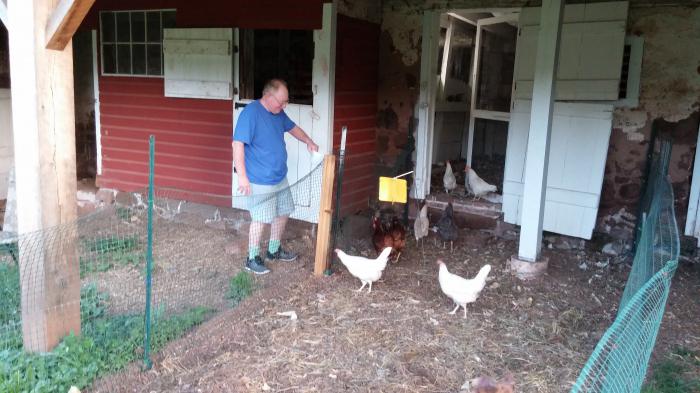

Varieties of Leghorn chickens
Of all the varieties of Leghorn chickens, Russian poultry breeders prefer white ones. The dwarf subspecies is also in demand, but these birds are slightly inferior to the standard ones in terms of egg production. At the end of the 20th century, Soviet scientists bred another line of Leghorns - striped-motley, but it did not surpass white chickens in productivity.
White leghorn
The name of the species indicates that these chickens have white plumage. Outwardly, they look like representatives of the white Russian breed, as they have family ties. White leghorn is considered to be the most productive variety. Its advantage is also in the ability to adapt to different climatic conditions. These birds are unpretentious and peaceful.
Attention! Unlike the Russians, the Whites have lost their incubation instinct. This is one of their disadvantages.
Striped mottled
This subspecies is the fruit of the labor of Soviet breeders. It was bred in the 80s of the 20th century using the gene pool of black australorphes. These chickens are distinguished by their beautiful striped plumage. In terms of productivity, they are inferior to their white counterparts, laying hens give about 220 eggs per year. The shell is rather dense, colored beige or brown. Striped leghorns are slightly smaller - the weight of an adult rooster does not exceed 2.5 kg, and layers - 2.1 kg.
Pygmy leghorn
This variety was also created by Soviet scientists, it is a miniature copy of the white leghorn. The subspecies was named B-33 and became in demand due to its high productivity indicators. Mini-hens produce up to 260 eggs per year, but consume 30% less feed than standard sized birds.
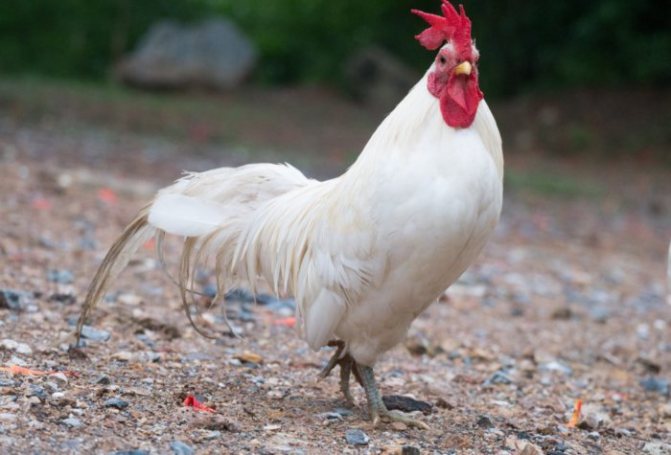

Rooster breed dwarf Leghorn
Dwarf Leghorn is unpretentious, peaceful, easily adapts to a new place, takes root well in cold regions. The disadvantage of dwarfs is the lack of incubation instinct.
Origin of the breed
The history of Leghorn began in Italy, therefore sometimes this breed is also called the Italian Leghorn rooster. The breed can be attributed to the egg and at the same time to the meat orientation.Note that at that time, they did not have any particular attractiveness for breeding, since the egg production indicator was at a very low level, deleting the breed from the TOP list. Chickens were also common in the United States, where local farmers conducted experiments on them crossing Leghorns with other breeds.
Further breeding work was carried out in Europe. It should be noted that local breeders did a huge amount of work before they were able to increase the egg production of the breed. Another significant success of the Europeans was the increase in the growth of young animals. Thus, the attractiveness of the Leghorn breed began to grow at a rather significant rate. A laying hen saw the Soviet Union in 1925. With the development of poultry farming, the country's leadership also relied on the Leghorn breed, it was then that the White Leghorn chicken was bred. It happened in 1960. Nowadays, the breed has proved to be quite popular in the matter of breeding new highly egg-producing chicken breeds.
Dwarf variety
Leghorn is also a dwarf variety, it is the same breed only in a reduced copy. The dwarf breed is considered a super egg breed. Despite the small size of individuals, the eggs that the Leghorn hen bring in in terms of their weight and dimensions are not inferior to other similar breeds. In terms of productivity, the Leghorn dwarf has very good performance. Dwarf Leghorn B33 is famous for its egg production up to 280 pieces per year.
An adult female of the dwarf white leghorn variety weighs 1.2-1.4 kg. Male 1.4-1.7 kg. Their feather color is white, but brown is also often found. The characteristic of mini leghorns is such that they begin to rush from 4 months, regardless of whether it is a poultry farm or a private backyard. Dwarf Leghorn and its characteristics indicate the unusual temperament of these individuals. Chickens can travel decent distances in search of food. It is very important for such individuals to go for a daily walk in search of pasture, and late in the evening to return to the roost so that the breed of mini dwarf Leghorn chickens does not stagnate in the cages.
The mini Leghorn chickens in the photo show that they love to fly and can fly to the level of trees, so give them that opportunity. It's just that if you think that chickens and chickens may fly off your site, then you can install a high mesh fence or fence. Dwarf birds are wary and apprehensive about humans. In the presence of a person, they can become nervous. You can study the dwarf species in more detail in photos or video resources.
Breeding Leghorns
Particular attention should be paid to this feature of the breed: Leghorns cannot boast of developed maternal instincts, this is expressed in the chicken's inability to incubate an egg. Thus, it is possible to obtain an addition only with the use of incubation technologies or to make a lining of eggs for a hen of a different breed. The best way to purchase an incubator is an automatic one, it will maintain the required temperature and humidity for growing eggs, and some incubators have the ability to turn the testicles on their own. When you place immature eggs in it, then all chicks hatch at about the same time with a difference of up to 5 hours.
Before laying eggs in the incubator, it is absolutely impossible to wash them. The fact is that on each egg there is a special protective film, it is invisible, transparent, but protects the future chick from the penetration of viruses and bacteria. The film is located on top of the shell, so it cannot be washed or squeezed. If there is chicken droppings on the eggs, then it must be carefully removed.
Dirty eggs should not be placed in the incubator.
From the very first days, the chicks are fed with an egg, having previously rolled it in flour.When the babies get a little older, they carefully begin to add greens, ground grain, bone meal to the food. From the age of one month, the chickens are transferred to adult feeding. In the warm season, all birds should be taken out for a walk, and it is better to build a transition from the house to the street, so that, if desired, individuals can graze on the grass all day. Chickens that spend more time in the fresh air fight less and do not go into conflicts. Fresh air and healthy grass have a calming effect on birds.

